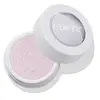What's inside
What's inside
 Key Ingredients
Key Ingredients

 Benefits
Benefits

No benefits
 Concerns
Concerns

 Ingredients Side-by-side
Ingredients Side-by-side

Mica
Cosmetic ColorantOctyldodecanol
EmollientBoron Nitride
AbsorbentMagnesium Aluminum Silicate
AbsorbentMagnesium Stearate
Cosmetic ColorantIsopropyl Isostearate
EmollientDimethicone
EmollientTocopherol
AntioxidantHelianthus Annuus Seed Oil
EmollientPolyglyceryl-2 Triisostearate
EmulsifyingCaprylyl Glycol
EmollientHexylene Glycol
EmulsifyingSilica
AbrasiveDehydroacetic Acid
PreservativeBenzyl Alcohol
PerfumingPhenoxyethanol
PreservativeCI 77491
Cosmetic ColorantCI 77492
Cosmetic ColorantCI 77499
Cosmetic ColorantCI 77891
Cosmetic ColorantMica, Octyldodecanol, Boron Nitride, Magnesium Aluminum Silicate, Magnesium Stearate, Isopropyl Isostearate, Dimethicone, Tocopherol, Helianthus Annuus Seed Oil, Polyglyceryl-2 Triisostearate, Caprylyl Glycol, Hexylene Glycol, Silica, Dehydroacetic Acid, Benzyl Alcohol, Phenoxyethanol, CI 77491, CI 77492, CI 77499, CI 77891
Dimethicone
EmollientIsononyl Isononanoate
EmollientTrimethylsiloxysilicate
EmollientDimethicone Crosspolymer
Emulsion StabilisingEthylhexyl Isononanoate
EmollientSilica
AbrasiveVinyl Dimethicone/Methicone Silsesquioxane Crosspolymer
Isopropyl Myristate
EmollientPhenoxyethanol
PreservativeStearalkonium Hectorite
Gel FormingEthylhexylglycerin
Skin ConditioningSynthetic Fluorphlogopite
Propylene Carbonate
SolventCI 75470
Cosmetic ColorantCI 77510
Cosmetic ColorantMica
Cosmetic ColorantCI 77891
Cosmetic ColorantDimethicone, Isononyl Isononanoate, Trimethylsiloxysilicate, Dimethicone Crosspolymer, Ethylhexyl Isononanoate, Silica, Vinyl Dimethicone/Methicone Silsesquioxane Crosspolymer, Isopropyl Myristate, Phenoxyethanol, Stearalkonium Hectorite, Ethylhexylglycerin, Synthetic Fluorphlogopite, Propylene Carbonate, CI 75470, CI 77510, Mica, CI 77891
 Reviews
Reviews

Ingredients Explained
These ingredients are found in both products.
Ingredients higher up in an ingredient list are typically present in a larger amount.
Ci 77891 is a white pigment from Titanium dioxide. It is naturally found in minerals such as rutile and ilmenite.
It's main function is to add a white color to cosmetics. It can also be mixed with other colors to create different shades.
Ci 77891 is commonly found in sunscreens due to its ability to block UV rays.
Learn more about CI 77891Dimethicone is a type of synthetic silicone created from natural materials such as quartz.
What it does:
Dimethicone comes in different viscosities:
Depending on the viscosity, dimethicone has different properties.
Ingredients lists don't always show which type is used, so we recommend reaching out to the brand if you have questions about the viscosity.
This ingredient is unlikely to cause irritation because it does not get absorbed into skin. However, people with silicone allergies should be careful about using this ingredient.
Note: Dimethicone may contribute to pilling. This is because it is not oil or water soluble, so pilling may occur when layered with products. When mixed with heavy oils in a formula, the outcome is also quite greasy.
Learn more about DimethiconeMica is a naturally occurring mineral used to add shimmer and color in cosmetics. It can also help improve the texture of a product or give it an opaque, white/silver color.
Serecite is the name for very fine but ragged grains of mica.
This ingredient is often coated with metal oxides like titanium dioxide. Trace amounts of heavy metals may be found in mica, but these metals are not harmful in our personal products.
Mica has been used since prehistoric times throughout the world. Ancient Egyptian, Indian, Greek, Roman, Aztec, and Chinese civilizations have used mica.
Learn more about MicaPhenoxyethanol is a preservative that has germicide, antimicrobial, and aromatic properties. Studies show that phenoxyethanol can prevent microbial growth. By itself, it has a scent that is similar to that of a rose.
It's often used in formulations along with Caprylyl Glycol to preserve the shelf life of products.
Silica, also known as silicon dioxide, is a naturally occurring mineral. It is used as a fine, spherical, and porous powder in cosmetics.
Though it has exfoliant properties, the function of silica varies depending on the product.
The unique structure of silica enhances the spreadability and adds smoothness, making it a great texture enhancer.
It is also used as an active carrier, emulsifier, and mattifier due to its ability to absorb excess oil.
In some products, tiny microneedles called spicules are made from silica or hydrolyzed sponge. When you rub them in, they lightly polish away dead skin layers and enhance the penetration of active ingredients.
Learn more about Silica